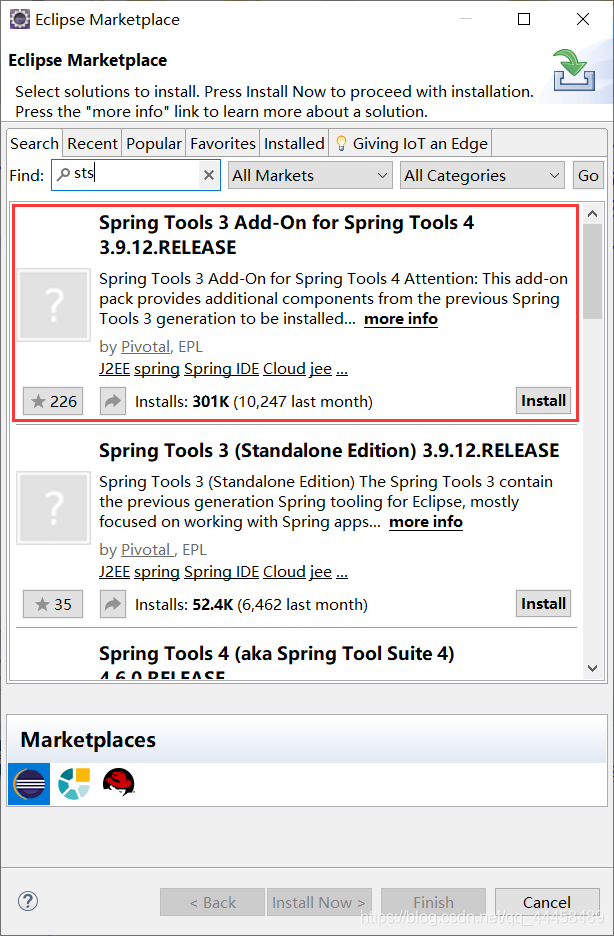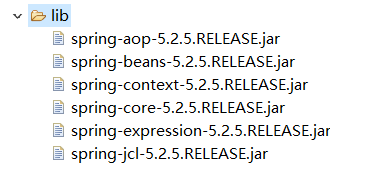Spring重要性
Spring是Java开发中最重要的框架之一
什么是Spring?
Spring是一个开源框架
准备工作
- 设置Eclipse中的代码格式为
UTF-8

- 安装插件,辅助工具

时间比较久,耐心等待 - 创建一个Java Project,并创建文件夹名为:resource,作用为:存放资源文件和配置文件

传统模式和IOC/DI思想的区别
传统模式
传统开发中创建对象的的方式 new关键字创建对象,其弊端为强耦合
代码部分:
Person.java
/**
* 原始人
* @author Katrina
*
*/
public class Person {
//武器
//private String tool = "枪"; //new 字符串
//private String tool = "手雷";
private String tool = "刀";
/**
* 战斗方法
*/
public void fight() {
System.out.println("Person用" + tool + "打僵尸");
}
}
PersonTest.java
/**
* Person测试类
* @author Katrina
*
*/
public class PersonTest {
public static void main(String[] args) {
Person person = new Person();
person.fight();
}
}
效果图:

IOC/DI思想
修改,变成松耦合
- IOC和DI
- IOC(控制反转):Invertion of Control,武器由原来的人生产,变成了由武器背包给人,这个武器产生的转变就称之为控制反转
- 代码层次:将类的创建由原来的代码控制,转变成外部生产注入,控制权由原代码变成了外部容器
- DI(依赖注入):Dependency Inject。
区别:
-
它们是spring核心思想的不同方面的描述。
-
依赖注入和控制反转是对同一件事情的不同描述,从某个方面讲,就是它们描述的角度不同。
依赖注入是从应用程序的角度在描述,可以把依赖注入描述完整点:应用程序依赖容器创建并注入它所需要的外部资源;而控制反转是从容器的角度在描述,描述完整点:容器控制应用程序,由容器反向的向应用程序注入应用程序所需要的外部资源。
代码部分:
思路:背了背包(武器包),需要枪从武器包里面取出枪,需要刀就从武器包中取出刀
PersonPlus.java
/**
* 升级版的人
* @author Katrina
*
*/
public class PersonPlus {
private String tool;
public String getTool() {
return tool;
}
public void setTool(String tool) {
this.tool = tool;
}
/**
* 战斗方法
*/
public void fight() {
System.out.println("升级版Person使用" + tool + "打僵尸");
}
}
PersonPlusTest.java
import java.util.ArrayList;
import java.util.List;
/**
* 升级版Person测试类
* @author Katrina
*
*/
public class PersonPlusTest {
public static void main(String[] args) {
//武器背包:IOC容器
List<String> bag = new ArrayList<String>();
bag.add("刀");
bag.add("枪");
bag.add("手雷");
bag.add("坦克");
//创建Person
PersonPlus personPlus = new PersonPlus();
personPlus.setTool(bag.get(0)); //升级版Person使用刀打僵尸
personPlus.fight();
}
}
效果图:

Spring简单操作
- Spring就是IOC思想的一种实现
Spring简单的使用:
一个容器:IOC
向容器中添加bean(实例):使用bean标签添加实例
1.赋值:属性赋值
1.1单值赋值:value、ref
1.2多值赋值:array、list、set、map
2.控制初始化等
取出bean(实例)创建容器取出值
注入类
第一步:
创建lib文件夹,添加jar包,并添加路径,效果图如下:



其中,spring-context依赖aop、beans、core、expression,而spring-core依赖jcl
第二步:
创建Student类及Book类,代码如下:
/**
* 学生类
* @author Katrina
*
*/
public class Student {
//名字
private String name;
//年龄
private int age;
public String getName() {
return name;
}
public void setName(String name) {
this.name = name;
}
public int getAge() {
return age;
}
public void setAge(int age) {
this.age = age;
}
}
/**
* 书籍类
* @author Katrina
*
*/
public class Book {
private String name;
private int page;
public String getName() {
return name;
}
public void setName(String name) {
this.name = name;
}
public int getPage() {
return page;
}
public void setPage(int page) {
this.page = page;
}
}
第三步:
创建config.xml并添加配置,代码部分如下:
<?xml version="1.0" encoding="UTF-8"?>
<beans xmlns="http://www.springframework.org/schema/beans"
xmlns:xsi="http://www.w3.org/2001/XMLSchema-instance"
xsi:schemaLocation="http://www.springframework.org/schema/beans http://www.springframework.org/schema/beans/spring-beans.xsd">
<!--
bean标签代表一个实例,一个类可以创建多个对象,反映在Spring当中就是可以创建多个bean标签
注入类(武器包):使用bean标签进行注入
class:指向类,值为类的全路径
id:标识,类在容器中的名字(方便取用)
-->
<bean class="spring.Student" id="student"></bean>
<bean class="spring.Book" id="book"></bean>
<bean class="spring.Book" id="book1"></bean>
<!-- tips:
1.bean可以多个
2.一个实例(对象)就是一个bean(可创建多个实例,只需修改id)
-->
</beans>
第四步:
创建测试类,即主程序代码,代码如下:
import org.springframework.context.support.ClassPathXmlApplicationContext;
/**
* Spring测试类
* 1.创建容器
* 2.取用类
* 3.测试
* 4.关闭容器
* @author Katrina
*
*/
public class SpringTest {
public static void main(String[] args) {
//1.创建容器(武器包)
ClassPathXmlApplicationContext context = new ClassPathXmlApplicationContext("config.xml");
// //2.取用类(武器)
// Student student = (Student) context.getBean("student"); //获取实例,需要强制转换,未转换之前为Object类型
// student.setName("小明");
// student.setAge(8);
// //3.测试
// System.out.println("学生的姓名是:" + student.getName() + ",年龄是:" + student.getAge()); //学生的姓名是:小明,年龄是:8
Book book = (Book) context.getBean("book");
Book book1 = (Book) context.getBean("book1");
System.out.println("book是:" + book);
System.out.println("book1是:" + book1);
//4.关闭容器
context.close();
}
}
效果图:

属性注入
给实例的变量初始化
set方法注入
第一步:
创建Student类及Mobile类,代码如下:
import java.util.List;
import java.util.Map;
import java.util.Set;
/**
* 学生类
* @author Katrina
*
*/
public class Student {
/*
* 八大基本类型、引用类型:
* 八大基本类型:byte、short、int、long、float、double、boolean、char
* 引用类型:String、自定义类、Array、List、Set、Map
*
* 单值:使用value或者ref赋值,其中value是直接量的形式;ref是引用形式,需要引用其他实例
* 多值:Array、List、Set、Map,使用对应的标签来进行赋值,如:<array>、<list>、<set>、<map>
*
*/
//名字
private String name;
//年龄
private int age;
//性别
private char sex;
//手机
Mobile mobile = new Mobile();
//数组
private String[] hobbies;
//list集合
private List<String> books;
//set集合
private Set<String> students;
//map集合
private Map<String, String> teachers;
public String getName() {
return name;
}
public void setName(String name) {
this.name = name;
}
public int getAge() {
return age;
}
public void setAge(int age) {
this.age = age;
}
public char getSex() {
return sex;
}
public void setSex(char sex) {
this.sex = sex;
}
public Mobile getMobile() {
return mobile;
}
public void setMobile(Mobile mobile) {
this.mobile = mobile;
}
public String[] getHobbies() {
return hobbies;
}
public void setHobbies(String[] hobbies) {
this.hobbies = hobbies;
}
public List<String> getBooks() {
return books;
}
public void setBooks(List<String> books) {
this.books = books;
}
public Set<String> getStudents() {
return students;
}
public void setStudents(Set<String> students) {
this.students = students;
}
public Map<String, String> getTeachers() {
return teachers;
}
public void setTeachers(Map<String, String> teachers) {
this.teachers = teachers;
}
}
/**
* 手机类
* @author Katrina
*
*/
public class Mobile {
//品牌
private String name;
public String getName() {
return name;
}
public void setName(String name) {
this.name = name;
}
}
第二步:
创建config.xml并添加配置,代码部分如下:
<?xml version="1.0" encoding="UTF-8"?>
<beans xmlns="http://www.springframework.org/schema/beans"
xmlns:xsi="http://www.w3.org/2001/XMLSchema-instance"
xsi:schemaLocation="http://www.springframework.org/schema/beans http://www.springframework.org/schema/beans/spring-beans.xsd">
<!--
bean标签代表一个实例,一个类可以创建多个对象,反映在Spring当中就是可以创建多个bean标签
注入类(武器包):使用bean标签进行注入
class:指向类,值为类的全路径
id:标识,类在容器中的名字(方便取用)
-->
<bean class="spring.Student" id="student">
<!-- 属性注入:给实例的变量初始化 -->
<!-- <property name="属性的名字" value="属性值"></property> -->
<property name="name" value="张三"></property>
<property name="age" value="10"></property>
<property name="sex" value="男"></property> <!-- 只写一个字:男/女 -->
<property name="mobile" ref="mobile"></property> <!-- 自定义类 || reference:关联 -->
<!-- 数组赋值 -->
<property name="hobbies" >
<array>
<value>吃饭</value>
<value>睡觉</value>
<value>打豆豆</value>
</array>
</property>
<!-- list赋值 -->
<property name="books">
<list>
<value>《高等数学》</value>
<value>《计算机原理》</value>
</list>
</property>
<!-- set赋值 -->
<property name="students">
<set>
<value>小明</value>
<value>小红</value>
</set>
</property>
<!-- map赋值 -->
<property name="teachers">
<map>
<!-- 键值对 -->
<entry key="语文" value="李四"></entry>
<entry key="数学" value="王五"></entry>
</map>
</property>
</bean>
<!-- 注入手机类 -->
<bean class="spring.Mobile" id="mobile">
<property name="name" value="华为"></property>
</bean>
<bean class="spring.Book" id="book"></bean>
<bean class="spring.Book" id="book1"></bean>
<!-- tips:
1.bean可以多个
2.一个实例(对象)就是一个bean(可创建多个实例,只需修改id)
-->
</beans>
第三步:
创建测试类,即主程序代码,代码如下:
import java.util.List;
import java.util.Map;
import java.util.Map.Entry;
import java.util.Set;
import org.springframework.context.support.ClassPathXmlApplicationContext;
/**
* 属性注入测试类
* @author Katrina
*
*/
public class PropertyTest {
public static void main(String[] args) {
//1.获取容器
ClassPathXmlApplicationContext context = new ClassPathXmlApplicationContext("config.xml");
//2.取用类
Student student = (Student) context.getBean("student"); //获取实例(id)的方式
//3.测试
/*
* 八大基本类型测试
*/
//System.out.println("学生的姓名是:" + student.getName() + ",学生的年龄是:" + student.getAge()
//+ ",学生的性别是:" + student.getSex());
/*
* 自定义类测试
*/
//System.out.println("手机的品牌是:" + student.getMobile().getName());
/*
* 数组测试
*/
// String[] hobbies = student.getHobbies();
// for (String hobby : hobbies) {
// System.out.println("学生的爱好是:" + hobby);
// }
/*
* list测试
*/
// List<String> books = student.getBooks();
// for (String book : books) {
// System.out.println("书籍的名称是:" + book);
// }
/*
*set测试
*/
// Set<String> students = student.getStudents();
// for (String stu : students) {
// System.out.println("学生姓名是:" + stu);
// }
/*
* map测试
*/
Map<String, String> teachers = student.getTeachers();
for (Entry<String, String> entry : teachers.entrySet()) {
System.out.println("课程的名称是:" + entry.getKey() + ",老师的姓名是:" + entry.getValue());
}
//4.关闭容器
context.close();
}
}
效果图:
推荐网址:
下载jar包
推荐https://search.maven.org/,此网站中可以从maven第三方库中下载所需要的jar包,例如:在search中输入spring-context,其中会出现很多group,点击其中一项效果如图所示:

学习Spring
推荐https://docs.spring.io/spring/docs/5.2.5.RELEASE/spring-framework-reference/index.html,此网站中可以学习到一些关于Spring架构的知识,注意是英文,效果如图下所示:


